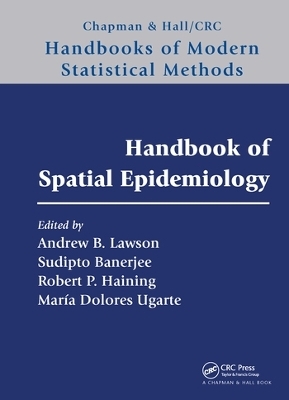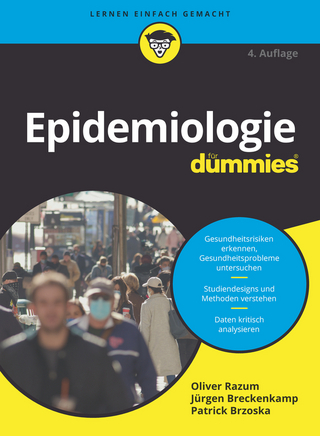
Handbook of Spatial Epidemiology
Chapman & Hall/CRC (Verlag)
978-0-367-57038-5 (ISBN)
Handbook of Spatial Epidemiology explains how to model epidemiological problems and improve inference about disease etiology from a geographical perspective. Top epidemiologists, geographers, and statisticians share interdisciplinary viewpoints on analyzing spatial data and space–time variations in disease incidences. These analyses can provide important information that leads to better decision making in public health.
The first part of the book addresses general issues related to epidemiology, GIS, environmental studies, clustering, and ecological analysis. The second part presents basic statistical methods used in spatial epidemiology, including fundamental likelihood principles, Bayesian methods, and testing and nonparametric approaches. With a focus on special methods, the third part describes geostatistical models, splines, quantile regression, focused clustering, mixtures, multivariate methods, and much more. The final part examines special problems and application areas, such as residential history analysis, segregation, health services research, health surveys, infectious disease, veterinary topics, and health surveillance and clustering.
Spatial epidemiology, also known as disease mapping, studies the geographical or spatial distribution of health outcomes. This handbook offers a wide-ranging overview of state-of-the-art approaches to determine the relationships between health and various risk factors, empowering researchers and policy makers to tackle public health problems.
Andrew B. Lawson is a professor of biostatistics in the Division of Biostatistics, Department of Public Health Sciences, College of Medicine at the Medical University of South Carolina (MUSC). He is an MUSC eminent scholar and American Statistical Association (ASA) fellow. He is also an advisor in disease mapping and risk assessment for the World Health Organization, the founding editor of the journal Spatial and Spatio-Temporal Epidemiology, and the author of eight books, including the highly regarded Chapman & Hall/CRC book Bayesian Disease Mapping: Hierarchical Modeling in Spatial Epidemiology, Second Edition. He has published more than 150 journal articles on spatial epidemiology, spatial statistics, and related areas. He earned a PhD in spatial statistics from the University of St. Andrews. Sudipto Banerjee is a professor and chair in the Department of Biostatistics at the University of California, Los Angeles. He is an elected fellow of the ASA, the Institute of Mathematical Statistics, and the International Statistical Institute. He is also a recipient of the Mortimer Spiegelman Award from the American Public Health Association. He is the author/coauthor of more than 100 peer-reviewed publications and two highly regarded Chapman & Hall/CRC books: Hierarchical Modeling and Analysis for Spatial Data, Second Edition and Linear Algebra and Matrix Analysis for Statistics. His research interests include hierarchical modeling and Bayesian inference for spatially referenced data. Robert Haining retired as a professor of human geography from the University of Cambridge in September 2015. He is the author/coauthor of more than 150 articles and two books. His research focuses on the quantitative analysis of geographical data, including the geography of health, spatial representation, spatial sampling, exploratory data analysis, small-area estimation and hypothesis testing, spatial data analysis, and spatial econometrics. His past work has involved the evaluation of the impact of air pollution on health status using small-area statistics as well as the development of new methods for evaluating the effectiveness of small-area targeted police interventions. María Dolores Ugarte is a professor of statistics at the Public University of Navarre. She is the author/coauthor of many papers on statistics and epidemiology and several books, including the recent Chapman & Hall/CRC book Probability and Statistics with R, Second Edition. She is also an associate editor for Statistical Modelling, TEST, and Computational Statistics and Data Analysis as well as an editorial panel member of Spatial and Spatio-Temporal Epidemiology. Her research focuses on spatiotemporal disease mapping and small-area estimation with applications in several fields. She earned a PhD in statistics from the Public University of Navarre.
Part I: Introduction
Chapter 1: Integration of Different Epidemiologic Perspectives and Applications to Spatial Epidemiology
Sara Wagner Robb, Sarah E. Bauer, John E. Vena
Chapter 2: Environmental Studies
Mark J. Nieuwenhuijsen
Chapter 3: Interpreting Clusters of Health Events
Geoffrey Jacquez, Jared Aldstadt
Chapter 4: Geographic Information Systems in Spatial Epidemiology and Public Health
Robert Haining, Ravi Maheswaran
Chapter 5: Ecological Modeling: General Issues
Jon C. Wakefield, Theresa R. Smith
Part II: Basic Methods
Chapter 6: Case Event and Count Data Modeling
Andrew B. Lawson
Chapter 7: Bayesian Modeling and Inference
Georgiana Onicescu, Andrew B. Lawson
Chapter 8: Statistical Tests for Clustering and Surveillance
Peter A. Rogerson, Geoffrey Jacquez
Chapter 9: Scan Tests
Inkyung Jung
Chapter 10: Kernel Smoothing Methods
Martin L. Hazelton
Part III: Special Methods
Chapter 11: Geostatistics in Small-Area Health Applications
Patrick E. Brown
Chapter 12: Splines in Disease Mapping
Tomás Goicoa, Jaione Etxeberria, and María Dolores Ugarte
Chapter 13: Quantile Regression for Epidemiological Applications
Brian J. Reich
Chapter 14: Focused Clustering: Statistical Analysis of Spatial Patterns of Disease around Putative Sources of Increased Risk
Lance A. Waller, David C. Wheeler, Jeffrey M. Switchenko
Chapter 15: Estimating the Health Impact of Air Pollution Fields
Duncan Lee, Sujit K. Sahu
Chapter 16: Data Assimilation for Environmental Pollution Fields
Howard H. Chang
Chapter 17: Spatial Survival Models
Sudipto Banerjee
Chapter 18: Spatial Longitudinal Analysis
Andrew B. Lawson
Chapter 19: Spatiotemporal Disease Mapping
Andrew B. Lawson, Jungsoon Choi
Chapter 20: Mixtures and Latent Structure in Spatial Epidemiology
Md. Monir Hossain and Andrew B. Lawson
Chapter 21: Bayesian Nonparametric Modeling for Disease Incidence Data
Athanasios Kottas
Chapter 22: Multivariate Spatial Models
Sudipto Banerjee
Part IV: Special Problems and Applications
Chapter 23: Bayesian Variable Selection in Semiparametric and Nonstationary Geostatistical Models: An Application to Mapping Malaria Risk in Mali
Federica Giardina, Nafomon Sogoba, Penelope Vounatsou
Chapter 24: Computational Issues and R Packages for Spatial Data Analysis
Marta Blangiardo, Michela Cameletti
Chapter 25: The Role of Spatial Analysis in Risk-Based Animal Disease Management
Kim B. Stevens, Dirk U. Pfeiffer
Chapter 26: Infectious Disease Modelling
Michael Höhle
Chapter 27: Spatial Health Surveillance
Ana Corberán-Vallet and Andrew B. Lawson
Chapter 28: Cluster Modeling and Detection
Andrew B. Lawson
Chapter 29: Spatial Data Analysis for Health Services Research
Brian Neelon
Chapter 30: Spatial Health Survey Data
Christel Faes, Yannick Vandendijck, Andrew B. Lawson
Chapter 31: Graphical Modeling of Spatial Health Data
Adrian Dobra
Chapter 32: Smoothed ANOVA Modeling
Miguel A. Martinez-Beneito, James S. Hodges, and Marc Marí-Dell’Olmo
Chapter 33: Sociospatial Epidemiology: Segregation
Sue C. Grady
Chapter 34: Sociospatial Epidemiology: Residential History Analysis
David C. Wheeler, Catherine A. Calder
Chapter 35: Spatiotemporal Modeling of Preterm Birth
Joshua L. Warren, Montserrat Fuentes, Amy H. Herring, Peter H. Langlois
| Erscheinungsdatum | 01.07.2020 |
|---|---|
| Reihe/Serie | Chapman & Hall/CRC Handbooks of Modern Statistical Methods |
| Sprache | englisch |
| Maße | 178 x 254 mm |
| Gewicht | 453 g |
| Themenwelt | Mathematik / Informatik ► Mathematik |
| Studium ► Querschnittsbereiche ► Epidemiologie / Med. Biometrie | |
| Naturwissenschaften ► Biologie | |
| ISBN-10 | 0-367-57038-6 / 0367570386 |
| ISBN-13 | 978-0-367-57038-5 / 9780367570385 |
| Zustand | Neuware |
| Haben Sie eine Frage zum Produkt? |
aus dem Bereich


